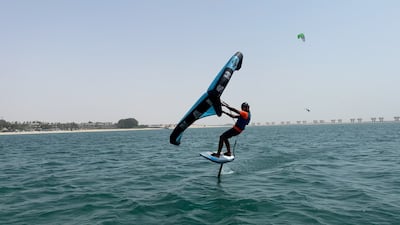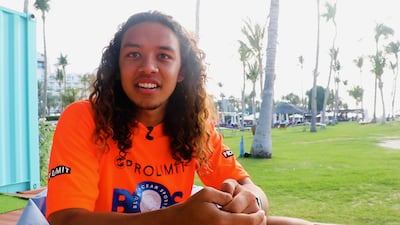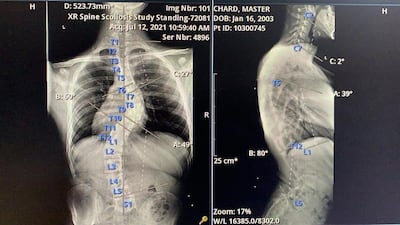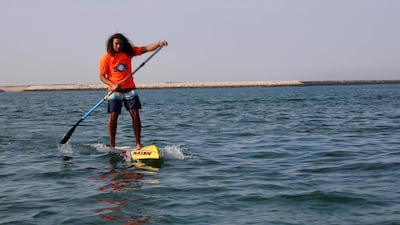Wind-powered aerial tricks and racing at eye-watering speeds across the choppy waters of Jebel Ali may not be the best treatment for a serious spinal condition but they appear to have worked wonders for one young athlete in Dubai.
Levi Chard, 20, who lives in Dubai, is determined to not let scoliosis stand in the way of achieving his dream of one day competing on the world stage.
Scoliosis is the abnormal twisting and curvature of the spine and usually appears in adolescence.
Kings College London, Dubai.
Untreated, the condition can worsen in severe cases where the curvature exceeds 50°, leading to decreased lung capacity and heart problems.
Despite having an S-shaped spine with a severe 47° curvature, Mr Chard has avoided 12-hour realignment surgery and the need for a corrective brace, largely thanks to the thousands of hours spent training on the water since childhood.
As a paddle-board racer and wingfoiler — wingfoiling is similar to windsurfing but on a hydrofoil — Mr Chard hopes to one day compete on the world tour of the rapidly growing sports, despite his back problems.
“I had been doing sports my whole life, without anything stopping me, when I was told I had scoliosis,” he said.
“I didn’t want to let it stop me doing what I love.
“I first went to the doctor two years ago. He said it may become a problem with my spine being twisted or pushing on to my muscles.
“As it was something I could manage, they said I would not need surgery which was a big relief.”
Surgery would involve doctors placing a cage around his spine, with tightened screws to straighten his back, from neck to coccyx.
Daily training sessions at Blue Ocean Sports, a purpose-built watersports academy at the Jebel Ali Beach Hotel run by his family, helped strengthen his core and spine-supporting muscles.
The centre has become a hub for wingfoiling, windsurfing and kitesurfing due to its huge expanse of clear, open waters and easy beach access.
It has become the perfect place for Mr Chard to hone his skills.
“Doing watersports for years has helped to build up back muscles,” he said.
“Doctors said it helped stabilise my spine, avoid surgery and at least stopped it getting worse.
“There is an opportunity to explore a career in watersports; yes, I have scoliosis but I won’t let it stop me.”

Most people develop scoliosis in their teens and face with corrective procedures that are hugely invasive and expensive.
For more minor cases, a tethered brace is usually worn for 20 hours a day during adolescent growth, while corrective surgeries usually take about 12 hours and require weeks of rehabilitation.
Mr Chard managed to avoid both, thanks to his long-term active lifestyle that has strengthened his core and back.
“Levi’s case was exceptional as he came to us with a large curve,” said Dr Nicandro Figueiredo, a spinal neurosurgeon at Kings College London, Dubai.
“People do not fully understand or recognise scoliosis so they come to us with very large curves, often with no knowledge of what the issue is.
“There is a weakness there with Levi, but that can be managed. He is not too old for surgery and he is below the 60° curvature for surgery.
“If he doesn’t progress, he can avoid it. We will see after two years.”
Rare condition
While there is no comprehensive UAE data, the global prevalence of scoliosis ranges from 0.47 percent to 5.2 per cent.
Prevalence and curve severity is higher for girls than boys and the female-to-male ratio rises with the increasing age of the children.
“Most scoliosis surgeons agree that children who have very severe curves of around 45° to 50° and higher will need surgery to lessen the curve and prevent it from getting worse,” said Dr Firas Husban, of Burjeel Hospital in Dubai.
“Spinal fusion surgery for scoliosis is extensive and only recommended when lateral curves are likely to cause severe deformity.
“It is important for patients to understand the potential complications of surgery.”
Convex curves to the right are more common, while C-curves or S-curves as in the case of Mr Chard are more unusual.
The condition is classified into three main types based on the cause. Congenital scoliosis is usually associated with birth defects in vertebrae while neuromuscular scoliosis occurs in children with neurological or muscular disorders.
Idiopathic scoliosis comprises about 80 per cent of all cases and is usually diagnosed during puberty.
Dr Vijayanth Kanagaraju, a specialist spinal surgeon at NMC Royal Hospital, DIP, said school screening would help doctors deliver treatment earlier to help avoid complications.
“Scoliosis is usually confirmed through a physical examination and an X-ray, while school screening for children allows diagnosis and to initiate early treatment,” he said.
“About 23 per cent of patients with idiopathic scoliosis presented with back pain at the time of initial diagnosis, while most of the children present to the clinic with a deformity in the back.”





